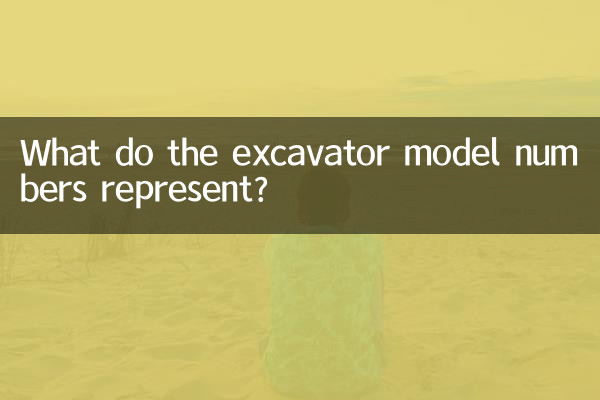What do the excavator model numbers represent? Analysis of hot topics on the Internet in the past 10 days
Recently, the topic of construction machinery has become increasingly popular on social media and industry forums, especially the meaning of excavator model numbers, which has triggered widespread discussions. This article will combine the hot content on the Internet in the past 10 days to analyze the secrets behind the excavator models for you, and attach structured data for reference.
1. The general meaning of excavator model numbers

Excavator models usually consist of letters and numbers, and the numbers often represent key parameters. The following is an analysis of common brand and model numbers:
| brand | Model example | Number meaning |
|---|---|---|
| Caterpillar | CAT 320 | "3" represents the excavator series, "20" represents the tonnage (about 20 tons) |
| Komatsu | PC200-8 | "200" represents 20 tons, "8" represents the 8th generation product |
| Sany Heavy Industry | SY215C | "215" stands for 21.5 tons, and "C" stands for third-generation technology |
2. Ranking of popular excavator models in the past 10 days
According to Baidu Index and WeChat Index data, the following models have the highest search volume recently:
| Ranking | Model | heat index | focus |
|---|---|---|---|
| 1 | CAT 336 | 8,520 | Mining performance |
| 2 | XCMG XE370DK | 6,780 | Advantages of domestically produced large tonnage |
| 3 | SANY SY75C | 5,930 | Market performance of micro-mining |
3. Correlation rules between model numbers and configurations
By comparing mainstream models, we found that there is the following correspondence between the digital part and the core configuration:
| Number field | Corresponding configuration | Example description |
|---|---|---|
| First two/three places | Working weight (tons) | PC200≈20 tons, SY75≈7.5 tons |
| last digit | technology generation | -8 means 8th generation, -5 means 5th generation |
| middle letter | special features | D means extended chassis, K means mine version |
4. The 5 most frequently asked questions by users
Based on discussions on Zhihu and Tieba:
1.Question:How big is the difference between different suffixes (such as -5/-7) of the same model?
Answer:Usually represents an upgrade to engine emission standards, -7 reduces fuel consumption by about 12% compared to -5
2.Question:Why do some model numbers not match actual tonnage?
Answer:Some manufacturers use "nominal tonnage". For example, the actual weight of SY75 is 8.2 tons.
3.Question:How much more expensive is Caterpillar's "E" series than its "D" series?
Answer:The price difference of the same model is about 15-20%, but the fuel efficiency is improved by 30%
4.Question:Why do small excavator models have decimals (such as 1.8 tons)?
Answer:The Japanese system is accustomed to using 0.5 tons as the grading unit, and domestic products are now gradually unified.
5.Question:What do the letters "LC" stand for in the model number?
Answer:Long Crawler (extended track), the grounding specific pressure is reduced by 20-25%
5. Purchase suggestions
Based on current market dynamics, the following suggestions are given:
1.Municipal engineering:Priority is given to the 5-8 ton class (such as SY60C), which is flexible in transition and can meet most working conditions;
2.Mining operations:For models with a "K" suffix above 30 tons (such as XE370DK), pay attention to matching bucket capacity;
3.Rural market:Pay attention to 1.8-3.5 tons microcomputers (such as PC30) and pay attention to the traveling motor configuration.
Through the structured data display and hot spot analysis in this article, I believe you have a clearer understanding of the digital password of the excavator model. It is recommended to make the final selection based on specific working conditions and the latest technical parameters.

check the details

check the details